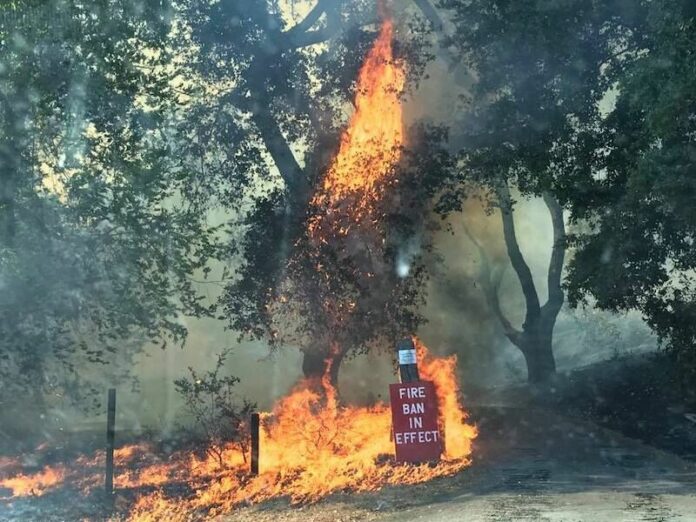Updated Aug. 34, 3 p.m. —
The following areas have been downgraded from a mandatory evacuation to an evacuation warning:
Map Grid 1D1 downgraded to Evacuation Warning
East of the Sonoma Coast
North of the Russian River
West of Myers Grade Road
South of Fort Ross Road
Map Grid 1D2 downgraded to Evacuation Warning
East of Myers Grade Road
North of the Russian River
West of Cazadero Highway
South of Fort Ross Road
NOTE: People returning to the area must utilize Highway 1 to return to their homes. Highway 116 remains closed east of Cazadero Highway.
Fire crews were able to hold the fire line Sunday night, as a fire weather watch and red flag warning warned about possible thunderstorms in the area which had the potential to ignite new fires and strengthen the existing ones in the LNU Lightning Fire Complex. Sonoma County was largely spared, however, with no notable storms or strikes. While strong downdrafts and wind between 20 and 30 miles per hour was reported on the line, an increase in moisture helped lessen the growth of the Walbridge Fire.
The winds Sunday night continued to push the fire toward the Dry Creek Valley and Westside Road areas, and it continued slowly backing down Mount Jackson toward Rio Nido and Guerneville.
“Today we’re looking to continue to connect those dots where those resources haven’t been able to tie those lines together,” said CalFire Division Chief Ben Nichols. “Resources are staffed on the line ready to go, and we’re looking for a productive day today.”
Because of the topography and structure layout of the region, CalFire can’t develop fire lines straight through and instead has to use a combination of bulldozers and hand crews to create a stable line.
As of 7 a.m. Monday morning, the Walbridge Fire was 5% contained and at 54,068 acres. The Meyers Fire is 95% contained and at 2,360 acres.
CalFire Incident Commander Sean Kavanaugh said that CalFire’s evacuation and repopulation team is working to determine when people evacuated from the fire area can return to their homes. He noted that, while no new evacuation orders have been lifted, he’s hoping to have news for people evacuated by the Meyers Fire in the coming day.
“When it comes to repopulation of areas, there’s a lot that plays into it. Just because we don’t have a fire threat that ends today and there’s not a fire there,” doesn’t mean they can immediately let people back in, Kavanaugh said. Before a place can be repopulated, crews have to go in and make sure there are no downed power lines or trees blocking roadways.
“For Sonoma County, we still have a very large incident that still can be a little unpredictable,” he said, noting that the future of the fire still largely depends on how the weather pattern develops.
In a CalFire press briefing, CalFire Unit Chief Shana Jones warned that California is just at the start of its fire season, and fires in the region have historically occurred later in the year. As such, CalFire is encouraging people to continue developing their fire preparedness knowledge by visiting its website, readyforwildfire.org.
The fires occurring earlier in the year than usual also mean that it’s more difficult to predict when 100% containment will be reached.
“What I do know is we’re taking it day by day every day,” Kavanaugh said. “This is a war, to be honest with you, and we try to win a battle every day. That’s what we’re doing. I just don’t have a timeframe for you.”
Looking forward, the county said it’s working on putting together local assistance centers for those who have lost their homes in the fire. With CalFire crews still on the ground doing a damage assessment, there isn’t currently an accurate number of structures lost to the fire. CalFire is hoping to have more concrete numbers in the coming days.
“We’re going to support you in the ways you want to be supported, not in the way the government or anybody thinks they should support you,” District 4 Supervisor James Gore said.
In addition to fire recovery, the county is also focusing efforts on fire prevention.
“While we’re still in the midst of an active disaster and we still need to maintain that situational awareness … I want to assure everyone that we’re already working on long-term and short-term recovery,” District 5 Supervisor Lynda Hopkins said.
Included in that is looking at ways the county can better prepare its land to reduce the risk of fire. The Walbridge Fire, unlike the 2017 Sonoma Complex Fires and last year’s Kincade Fire, is spreading because of dense timber and vegetation in the area.
“We cannot control the topography in west county, nor would I want to — I love our canyons and our beautiful mountains and our rugged coastline — but we can work on vegetation management and we can work on fuel reduction,” Hopkins said.
Rather than having densely populated forests, Hopkins said that she sees this fire as a wake-up call for Sonoma County to try and address its densely packed forests and instead look at creating areas that are more open like Armstrong Woods.
“We can create sort of a triple-positive benefit: reduce the fire risk reduction, we actually enhance carbon sequestration and we actually make a healthier ecosystem for our wildlife,” she said. “This is not about clear cutting versus saving every tree. This is about how we can wrap our heads around what is currently, unfortunately, an overstocked forest.”
“We have a moment to try to do better next time,” Hopkins said.









